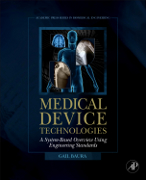Medical Device Technologies: A Systems Based Overview Using Engineering Standards
Purpose
In 2006, I returned to academia from the medical device industry and was asked to teach medical devices. To prepare for the course, I first listed appropriate topics. Electrical medical devices are traditionally taught in a bioinstrumentation course. I decided to construct a course with important electrical and mechanical medical devices. Then I searched for a textbook incorporating these topics, and found . . . nothing. I created my lectures from primary literature, constructed unusual lab experiments, and endured a grueling spring semester. After teaching this course twice, I formalized the general structure of each device lecture as: relevant physiology, mathematical modeling or biocompatibility, clinical need, historical devices, technology. I improved the technology section by discussing each medical device as a system. To encourage professors to provide evidence for ABET Criterion 5, I included requirements from applicable engineering standards in the technology section. I also strengthened the three FDA recall case studies I discuss, which provide a glimpse of the working conditions of medical device engineers. Five years later, these five teaching semesters have become this textbook.
The textbook has three audiences. First, because the only prerequisites are free body diagrams, introductory circuits, and introductory differential equations, it is appropriate for bioengineering students who are second semester sophomores and first semester juniors. Many bioengineering programs purport to prepare their students to enter the medical device industry, but most do not introduce their students to basic, modern medical devices. Second, because learning in context is known to result in a deeper understanding of subject matter and increased student engagement, the book is appropriate for electrical and mechanical engineering students, as well as bioengineering students. Institute of Electrical and Electronics Engineers (IEEE) President Moshe Kam recently stated that "the intersection between our traditional fields—electrical engineering, computer engineer, and computer science—and the life sciences is 'hot.' If we fail to capture this growing interest area, others will fill the gap". Third, for medical device engineers working on one type of medical device, the systems approach of this book provides connections to other devices. Common medical instruments are electrocardiographs, blood pressure monitors, pulse oximeters, thermometers, and respiration monitors. Common electrical stimulators are pacemakers, implantable cardioverter defibrillators (ICDs), cochlear implants, and deep brain stimulators.
Industries such as the medical device industry wish to hire graduates who are industry ready. The American Society of Mechanical Engineers determined from Vision 2030 surveys of 590 industrial managers that they believe current graduates are weak in overall systems perspective, "new technical fundamentals (new ME applications _ bio, nano, info, etc.)" and engineering codes and standards . The Institute of Electrical and Electronic Engineers Board of Directors recently approved a position paper that declares "introducing standards in the classroom will augment the learning experience by pointing students to available design tools, and to best industry practices". In one of its workshop summaries for its Moving Forward to Improve Engineering Education initiative, the National Science Board stated that "companies want engineers with . . . systems thinking; . . . an ability to understand the business context of engineering; . . . and an ability to change. The public sector especially needs engineers with a sophisticated understanding of the social environment within which their activity takes place, a system understanding, and an ability to communicate with stakeholders".
This textbook addresses all these issues, from the perspective of an author with thirteen years of medical device industry experience who is also an ABET bioengineering program evaluator. The text is a necessary first step for bioengineering graduates entering the medical device industry.
